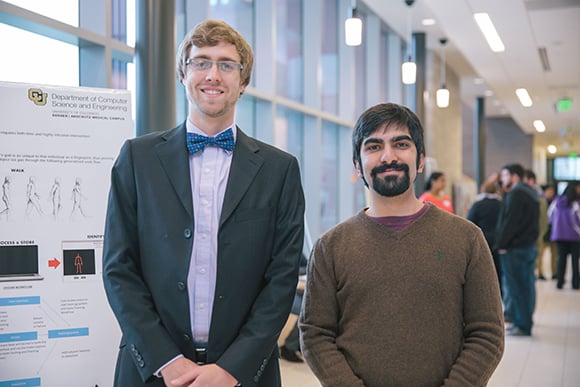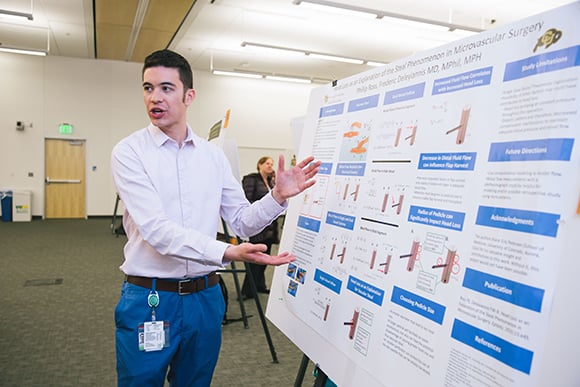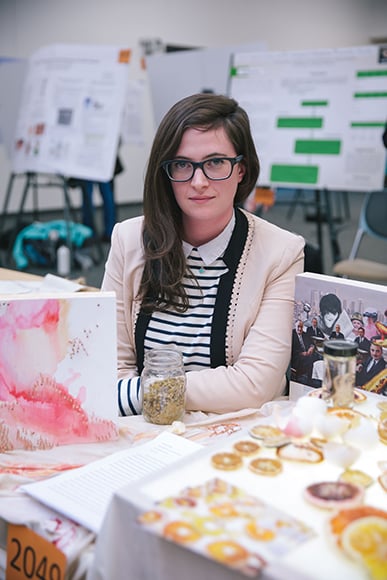The future of security might not be fingerprint readers or retina scanners—it could be your gait. That’s just one of the applications that David Attid and Andrew Gale, seniors from the Department of Computer Science and Engineering, are considering for the data they are collecting on gait. The team believes that the subtle, unique movements of individuals can be used for personal identification.
 Andrew Gale and David Attid showed off their work that explored gait as a method for human identification.
Andrew Gale and David Attid showed off their work that explored gait as a method for human identification.
Attid and Gale presented their project at the 19th annual Research and Creative Activities Symposium (RaCAS), held April 29 in the Student Commons Building. RaCAS provides a venue for CU Denver and CU Anschutz students to showcase their scholarly activities through presentations, posters, computer simulations, demonstrations, art and even puppetry. Nearly 300 undergraduate and graduate students delivered approximately 180 presentations encompassing a variety disciplines and industries.
“No other event showcases the diverse research, creative and other scholarly activities undertaken by students at CU Denver and CU Anschutz,” said Leo Bruederle, PhD, director of Undergraduate Research and Creative Activities and RaCAS. “For many students, this day will remain in their memory as a time at which they were recognized for something they did that was truly excellent.”
Gait for identification
Attid and Gale began exploring gait and its capacity for human identification for their senior project, alongside graduate student Siddhant Kulkarni, under the guidance of Farnoush Banaei-Kashani, head of the Big Data Management and Mining Lab.
The team employs a feature-based identification system that tracks the movement of 15 joints. Attid, Gale and Kulkarni designed the user interface and utilized an established skeleton capture framework. The result is a model that can capture data for individuals’ unique gait movement.
“Gait is unique to an individual,” Gale said. “We are thinking about how we can use that to enhance security. This could be used at a bank or an airport in lieu of credentials.”
Presenting at RaCAS has offered a team an opportunity to get reactions from attendees, as well as ideas on how to expand their research.
“Up until now it’s just been three guys in a room coding away to get the system to work,” Attid said. “It’s great because you see the fresh expressions of anyone who comes by to learn about this.”
Theory behind necrotizing organs
Flap resconstructive surgery, a procedure in which tissue is taken from one area of the body and overlaid on a wound, carries a potentially dangerous side effect. The flap, which must carry its own blood supply due to its size and must be sewn into existing blood vessels, can cause necrosis in the greater organ.
 Phillip Ross explains that necrosis of organs during flap surgery could be explained by "head loss."
Phillip Ross explains that necrosis of organs during flap surgery could be explained by "head loss."
The phenomenon is referred to as vascular steal, which ultimately sees blood being siphoned or stolen away from the organ, leaving it to die. Vascular steal was largely accepted as the rationale for the necrosis, which often lead to amputation.
Phillip Ross, a third-year School of Medicine student, presented a different theory at RaCAS. In a project titled “Head Loss as an Explanation of the Steal Phenomenon in Microvascular Surgery,” Ross proposes that “head loss” may actually be the culprit behind the necrotizing organs.
“Head loss occurs at the junction where two vessels meet,” Ross said. “When blood reaches a juncture where a new vessel has been sewn, it loses momentum that results in a lack of profusion to the end organ.”
Despite strong evidence to support the head loss explanation, Ross would like to take more steps to confirm the finding, including adding variables to a computational model and comparing patient cohorts to see if any statistical difference in the blood flow to organs occurs.
“I don’t consider this matter to be solved. There is still more work to be done,” said Ross. “However I hope this provides a new talking point and can generate a discussion between other scientists and surgeons in an effort to lock down this phenomenon.”
Ross decided to present at RaCAS as he saw the symposium as an opportunity to share his findings and learn from other presenters.
 Marian Gottlieb sheds light on how womanhood and beauty are explored in art.
Marian Gottlieb sheds light on how womanhood and beauty are explored in art.
“I knew RaCAS would be another great opportunity to showcase my work and also to see other scientific achievements that a lot of the graduate and undergraduate students have done as well,” Ross said.
Recontextualizing beauty
Brightly colored fabrics, a spray of flower petals and an assortment of eggshells are just a few objects arranged on BFA student Marian Gottlieb’s table. Among the curiosities is something that seemingly does not belong—a squid preserved in a jar of formaldehyde. But Gottlieb, who uses her art to explore the ideas of womanhood, women’s roles and women’s bodies in art, has an explanation for the inclusion.
“The objects symbolize womanhood, fertility and beauty—concepts frequently seen in feminist art,” Gottlieb said. “Preserving something and having something that is a curiosity to be viewed is how women’s bodies been historically viewed.”
Gottlieb’s goal is to find whether there is a way for contemporary artists to reclaim and recontextualize women’s bodies in art. This concept and the ways in which individuals experience and interpret beauty are ideas are central to her senior thesis.
“I am advocating for understanding beauty as an experience of the sublime and portraying beautiful people the way artists have traditionally represented the sublime,” Gottlieb said.
Sharing her art and research at RaCAS has allowed Gottlieb to hone in on key ideas in her thesis through discussing her work with others.
“RaCAS has been a really good way to clarify my ideas behind my thesis for myself,” Gottlieb said. “Doing a pitch about my thesis has helped me narrow down what I want to say.”
Gottlieb’s work will be featured at the CU Denver BFA Thesis Exhibition through May 14 at the RedLine Gallery.




